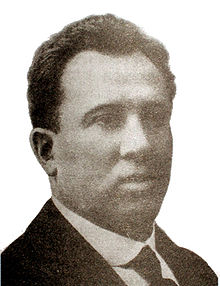Alexander Drankov
Alexander Osipovich Drankov | |
|---|---|
 | |
| Died | January 3, 1949 (aged 68) |
| Nationality | Russian |
| Occupation(s) | Film producer, photographer, cameraman |
| Website | Alexander Osipovich Drankov on IMDb |
Alexander Osipovich Drankov (
Biography
Drankov was born Abram Iosifovich Drankov (Абрам Иосифович Дранков).
1907-1908
In Fall 1907, Drankov advertised that he would open a movie studio, which he called a "cinematographic atelier".[6]. His announcement encouraged Pathé to create their first Russian film, Cossacks of the Don, which was extremely successful.[7]: 31–32 [2]: 21
Drankov read rumors that a foreign company planned to film a theatrical production of Boris Godunov in Moscow. Although no such plans actually existed, he decided to preempt the rumored film by creating his own, and found another theater which was performing the same play. The production was troubled; the theater was open-air, forcing Drankov to move and reassemble the set as the light changed, and he clashed with the actors over his proposed cuts to the script, which would omit roughly 80% of the play. Eventually, the lead actor refused to participate, leaving the film without its title character. Drankov would eventually screen his recorded footage under the names Scenes From Boyar Life and The False Dmitri.[4]
Drankov's studio released 17 short documentaries in 1908,[1] one of which captured footage of an active fire.[5] Drankov screened his films to Pyotr Stolypin, Maria Feodorovna, and a film exposition in Hamburg, making them the first Russian film exports.[7]: 32 In August 1908, he filmed Leo Tolstoy's 80th birthday.[7]: 33
On October 15, 1908, Drankov released Stenka Razin. Its production had begun over the summer, when Vasily Goncharov hired Drankov to capture footage for an experimental play about the Cossack leader. The play would begin and end with pre-recorded projected film, while the middle would be performed live. Drankov convinced Goncharov to let him film additional scenes, covering material that was intended for the live performance. Without Goncharov's permission, and without crediting him, Drankov released his footage as a stand-alone film one day before the play's premiere.[8] Drankov promoted his version of Stenka Razin as Russia's first feature film, ignoring his incomplete Boris Gudanov.[9] The film was an immediate success, and helped establish the Russian film industry.[6] Drankov followed this success with two comedies, including The Zealous Batman, the first Russian comedy film - both of which failed commercially, and another filmed play: The Marriage of Krechinsky.[7]: 35
1909-1916
In 1909, Drankov made a documentary about the assassination and funeral of Mikhail Herzenstein, which was censored in most of Russia.[10]
In 1909 and 1910, Drankov filmed additional footage of Leo Tolstoy. Tolstoy encouraged Drankov to record the lives of peasants, and helped organize a wedding for that purpose. Two months after Tolstoy's death, Drankov released the footage as A Peasant Wedding, and claimed that Tolstoy personally wrote and directed it.[7]: 41–46
Drankov developed a rivalry with fellow Russian director
In 1913, Khanzhonkov announced a four-reel film about the Romanovs, celebrating 300 years of the dynasty's rule. In response, Drankov made a competing seven-reel film, receiving Nicholas II's personal approval and access to authentic historical costumes from a museum. Drankov hired Yevgeni Bauer as a set decorator, which marked Bauer's entry into film industry.[5]: 214 The two films were released simultaneously, but Khanzhonkov's was better received.[7]: 64
Between 1914 and 1915, Drankov created a serial about
1917-1949
In 1917, the Russian Provisional Government recruited filmmakers, including Drankov, to make anti-Bolshevik films.[7]: 103–104 That same year, Drankov also created a film glorifying Catherine Breshkovsky.[2]: 119 Later that year, as supplies of film ran low, Drankov took a break from filmmaking and managed Yekaterina Geltzer on tour.[10]
In 1918, Drankov left Moscow for
Drankov died of a heart attack on 3 January 1949. He is buried in the Jewish Eternal Home cemetery in Colma, California.[10]
Reception and legacy
Despite his prolific output and popular success, Drankov's films were considered inartistic. They did not play at prestigious movie theaters, and Drankov was unable to recruit serious theater directors to his studio.[1] His films were criticized for their sensationalism and for making light of crime.[2]: 25–27
Despite his important role in Russia cinema, Drankov's reputation is largely negative. He developed a reputation for being ruthless and aggressive, and has been characterized as a "gangster".[1][5]: 206–207
References
- ^ ISBN 978-0-8108-6072-8.
- ^ ISBN 0-299-16234-6.
- ^ Александр ПОЗДНЯКОВ, пристанище Александра Дранкова
- ^ ISBN 978-0-415-04951-1.
- ^ ISSN 0037-6795.
- ^ ISBN 978-1-61811-212-5.
- ^ ISBN 9780691003467.
- ISBN 0-253-21479-3.
- ISBN 978-1-78453-159-1.
- ^ ISSN 0892-2160.
- ISBN 0-19-811257-2.
- ISBN 978-0-786-44350-5.
External links
- Alexander Drankov at IMDb
- "Tercentenary of the Romanov Dynasty's Accession" (1913) on YouTube
